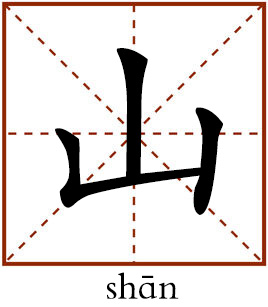Hill

This character refers to mountains or hills. Mountains are of key importance to Chinese culture. Literati always acquire inspiration from mountains. Sometimes they served as a symbol, such as jiang shan (rivers and mountains), which refers to the country. They also appear in literature, conveying a reflection of life or a grand atmosphere.
不识庐山真面目
bù shí lú shān zhēn miàn mù
Bu shi refers to failing to see or know something. Lushan is Mount Lu, situated in the northern part of Jiangxi province in Central China and is one of the most renowned mountains in the country. Zhen refers to being real or true while mian mu refers to face or image. This verse, taken literally, means that one fails to see the true image of Mount Lu. It often indicates a failure to see the truth about a person or a matter.
This is a verse from a poem by the Song poet Su Shi (1037—1101), “Written on the Wall at West Forest Temple.” “It’s a range viewed in face and peaks viewed from the side,/ Assuming different shapes viewed from far and wide./ Of Mountain Lu we cannot make out the true face,/ For we are lost in the heart of the very place.” (Translated by Xu Yuanchong) This poem incorporates a philosophical connotation about the dialectical relationship between the “whole” (or totality) and the “parts” into the scenery of Mount Lu. In the former part of the poem, Su observed the diverse shapes of Mount Lu from different perspectives and distances. In the later part, he noted the reason why he could not see the “true face” of the mountain was because he himself was in the mountain (or the “part”). Su drew the conclusion that one could only see the truth about a person or a matter when he was unfettered by the bounds of reality and observed a matter as a whole rather than focusing on its parts. It also illustrates that Su was many-sided because he could view everything far and near, see its sunny side as well as its shady one, understand all and pardon all.
Nowadays, this verse is often used to remind people to see a situation from multiple perspectives and build critical thinking skills so as to avoid making poor decisions.
(edited by REN GUANHONG)
